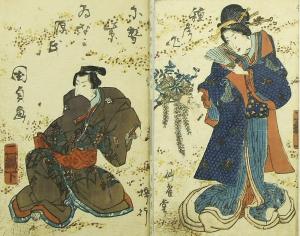A Fake Murasaki and a Rural Genji (Nise Murasaki Inaka Genji)
Written by Ryutei Tanehiko and painted by Utagawa Kunisada 1829-1842 (Bunsei 12 to Tempō 13) Kaga Collection 12369
This is a representative work of gōkan, a kind of popular literature with pictures called kusazōshi or ezōshi, which depicts, within the context of the Muromachi period, the world of the "Genji Monogatari (the Tale of Genji)" written by Murasaki Shikibu in the Heian period. The gōkan was developed, as a form of the Edo literature, from akahon (red book), kurohon (black book), aohon (blue book), and kibyōshi (illustrated storybook with a yellow cover) in ascending order according to time, and several volumes (one volume consisting of 5 pages) were unified as one gōkan, which allowed other writers to make up feature-length stories.
Nise Murasaki Inaka Genji (A Fake Murasaki and a Rural Genji) is an ezōshi with a series of long stories adapted from the "Tale of Genji", the first issue of which was released in 1829. After that 38 books (each with 4 volumes) were issued in total.
The author, Ryūtei Tanehiko (1783-1842) came from the Hamato family, who were direct retainers to the Shogun, and studied Japanese classical literature. He completed the work as a kind of mystery with the taste of the worlds of kabuki and jōruri, referring to commentaries and other easy-to-understand descriptions of the "Tale of Genji."
The scenes introduced here are the covers and illustrations depicted on the two volumes in one: Mitsu-uji, a lead character, is handing over a secret letter disguised as a love letter tied to the branch of Japanese wisteria on the cover of the second volume and Fuji-no-kata (Fujitsubo-no-nyogo, a court lady) in a haori jacket is receiving the letter on the cover of the first volume.
In 1842, the book was forced to go out of print. One reason was that the life of Mitsu-uji was rumored to reflect those of the Shogun at that time, Tokugawa Ienari, and his official concubines. The 39th and 40th volume remain as drafts.


